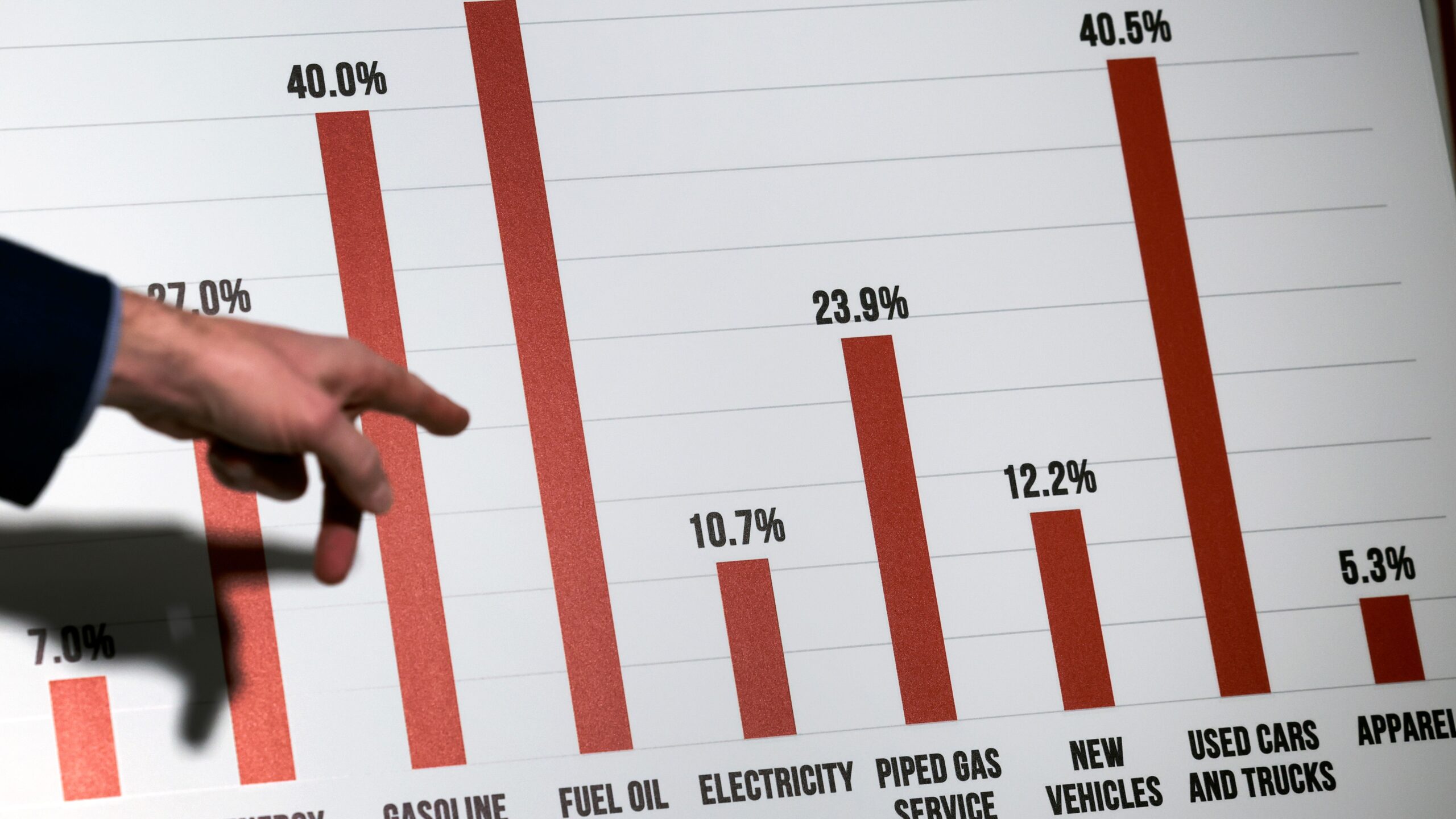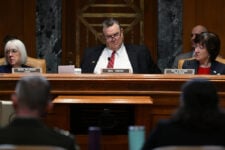
WASHINGTON, DC – FEBRUARY 16: U.S. Sen. Todd Young (R-ID) references a chart on rising costs during a press conference on inflation, at the Russell Senate Office Building on February 16, 2022 in Washington, DC. The Republican Senators blamed the near record high inflation on the Biden Administration and the Democratic fiscal agenda. (Kevin Dietsch/Getty Images)
With everything from food to gas prices rising, Congress asked the Pentagon to weigh in and say how inflation will impact its $773 billion budget request. But the Hill didn’t get the answers it expected. Below, AEI scholars John Ferrari and Mackenzie Eaglen argue that was a missed opportunity from department leadership.
Congress is worried about inflation — for their constituents, the nation’s finances, and the military. But the Hill’s plea for more information from the Department of Defense (DoD) to help ameliorate the negative impacts on the armed forces brought little new to light. The Pentagon’s response had echoes of Jerry Maguire’s classic “help me… help you” scene: Congress is desperate to help the department, and so one would expect the Pentagon to take advantage.
That just doesn’t seem to be happening. In fact, defense leadership’s 12-page memorandum in response to Congress essentially says five things:
- No inflationary adjustments were made to the budget since November
- The Pentagon does not track inflation’s effect in budget execution
- Leaders are not updating their forecasts even though six months of new data has emerged
- No financial help is needed from Congress at this time; and
- None in the department are seeking a higher pay raise for military members because of inflation.
Despite spending nearly half of all federal discretionary funds each year, the Pentagon admits that its staff do not collect actual inflation-related data when funds from Congress are executed. Instead, DoD just monitors overall spending levels, without regard to the cost-of-output.
Worse, given the sustained spike in inflation with no letup in sight, the Pentagon has no plans to hire any outside entities to study the effects of inflation. This is like being the proverbial frog in the boiling pot of water: the Pentagon will never know what the temperature actually is until they’re boiled alive, budgetarily speaking.
Even though the Pentagon’s response to Congress is now six-months past when it locked its budget, department leaders failed to take this opportunity to provide an update on whether its forecasts are accurate and, if not, how off those forecasts are in order for Congress to estimate the magnitude of the problem. Without realistic estimates of actual impact, how can targeted assistance be helpful?
Yet there is no doubt there is a very real inflation problem. The Defense Department prefers to use the Gross Domestic Product chain-type price index (GDP-PI), which they estimated to be 3.9%. But this price index has increased radically over the past fiscal year, with the most recent estimates hitting 8.0%. If there is any proof as to how far off the administration’s 3.9 percent estimate was, it is that the GDP-PI index has not been below 4.3% since 2020.
RELATED: How the Pentagon’s bad inflation math made a hollow budget
Further, this particular index still anticipates a gradual relief from today’s pressure over the next fiscal year—a rosy outlook few Americans expect. The GDP-PI benchmark is generously low, too, compared to “itemized” inflation rates for products like groceries, rent, and home utilities like water and electricity.
Given these worrisome facts, Congress has asked what help the military may need. Defense leaders responded in the very last answer of the memo that the “Department has not identified any required additional authorities… to address the current inflation spike.” It defies logic, nearly eight months into the fiscal year, with next year’s defense bill markups about to start, why Pentagon leaders did not take advantage of this opportunity.
Here’s the reality for department leaders: Congress is almost certainly going to act to increase the Pentagon’s budget with inflation in mind, and if you don’t tell them where the money should go, it might not go into the things that you actually want.
It’s particularly egregious when Deputy Secretary of Defense Kathleen Hicks said recently that the impacts of current inflation for this fiscal year need to be addressed this summer by Congress. That is a de facto admission of error in previous inflation assumptions. There is no reason to think the outlook has improved, and the memo should have reflected that widely held knowledge. On time appropriations are indeed important, as Hicks asked for, and Congress should absolutely act accordingly. But the hope of relying on supplemental spending bills next year to address gaps in inflation assumptions, as Hicks said is the department’s default solution to address inflation, is not the wisest course of action.
Instead, leaders should first admit that the Pentagon forecast is wrong by a large margin. It is difficult to ask for assistance without admitting the estimates were wrong. Then, at a minimum, the Pentagon should ask for additional reprogramming authority for FY22 and FY23 that will enable the services to help themselves accordingly.
Next, the Pentagon should ask for a two-year inflation transfer fund to help blunt some of the impact of inflation, as it arises in both FY22 and FY23, for the procurement, military construction, and operations and maintenance appropriations accounts. To assist Congress in making decisions, the Pentagon should provide detailed tables of what a 4% inflation miscalculation (read: shortfall) would mean to specific accounts going forward, which is different from the retroactive tables they provided to Congress in their response.
One area Congress seems certain to act is in personnel. In the memo to Congress, defense officials are content with the requested 4.6% pay raise, which they say is in line with what the law requires to keep pay competitive with the private sector.
It is no secret the military services are having enormous difficulties recruiting. While DoD assumes that the pay raise is competitive, the actual observed outcome is that they are failing in their recruiting mission, causing the services to pay much larger bonuses instead. More importantly, the Pentagon response fails to explain the impact on troops from pay raises that fall short of actual inflation, not acknowledging that they are experiencing a real pay cut. Leaders are effectively failing to advocate for servicemembers or their families.
Since the Pentagon’s response landed on Capitol Hill, another round of inflation data was released. The Consumer Price Index (CPI) inflation remains near a 40-year high at 8.3%—the same benchmark servicemembers and their families experience in meeting daily needs. Additionally, the Producer Price Index (PPI) for inflation remains above 11%. The preferred Pentagon index is now also near a 40-year high.
In sum, there are no inflationary trendlines moving in the right direction to ease congressional concerns for the US military. The Pentagon’s statement that “today’s data offer us only limited insight into what will be happening during FY 2023” is simply not true.
All inflation lights are blinking red.
Defense officials need to provide Congress with a roadmap on how to ensure the readiness and well-being of our armed forces. If left unaddressed, recruiting will continue to tank and troops will vote with their feet and exit service. Congress is begging the Pentagon to accept its offer to help. Defense leaders must say yes.
Maj. Gen. John Ferrari, US Army (ret.), is a visiting fellow at the American Enterprise Institute (AEI) and is the former director of program analysis and evaluation for the US Army. Mackenzie Eaglen is a defense expert at the American Enterprise Institute (AEI) and member of the Breaking Defense Board of Contributors.






















